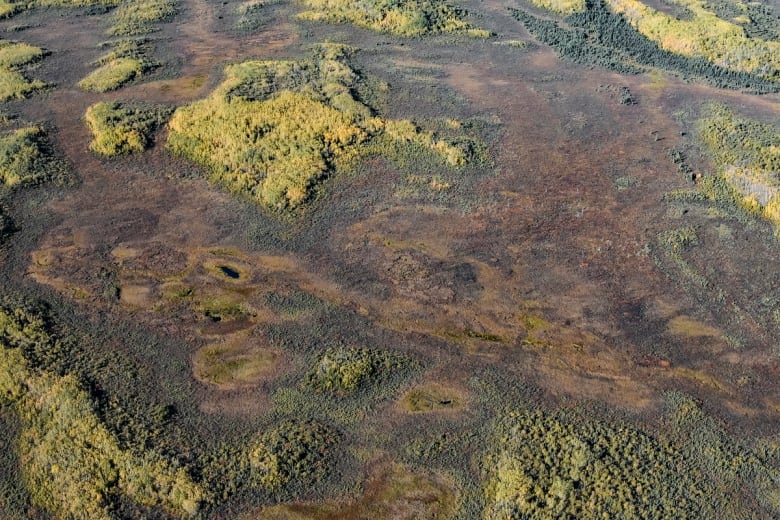What is the N.W.T. doing to protect its 'globally significant' peatlands?
Environment department developing carbon calculation maps to inform policy

Our planet is changing. So is our journalism. This story is the third and final in a series, by CBC North, that examines carbon storage with the N.W.T.'s natural environment. It's also part of a CBC News initiative entitled Our Changing Planet to show and explain the effects of climate change and what is being done about it.
Peatlands in the N.W.T. store immense amounts of carbon, and experts have said it's important to keep that carbon in the ground to curb further climate change. But they're hardly mentioned in the territory's climate change policies.
The 2030 NWT Climate Change Strategic Framework only mentions peat twice.
Peatlands are ecosystems that cover swaths of temperate, boreal and subarctic regions. They are filled with organic matter that's collected over thousands of years, and they are considered to be carbon sinks because of their capacity to store carbon as that organic matter decays.
They can be bogs, they can be forests, and they can also be permanently frozen.
The strategic framework acknowledges peatland plateaus — expanses of peat above a peatland surface with ice in between — are impacted by thawing permafrost, which transforms them into wetlands or fens. It also says understanding carbon storage in peat, vegetation, soil and wetlands is a "knowledge gap."
So what is the territory doing to address that gap?
Lorna Harris, a postdoctoral fellow and ecosystem scientist at the University of Alberta, told CBC News there are 24 billion tonnes of carbon stored in the N.W.T.'s peatlands alone. More broadly, Ducks Unlimited Canada says the territory contains about 55 billion tonnes of soil carbon.
Mapping permafrost
Tom Lakusta, manager of forest resources for the N.W.T.'s Department of Environment and Natural Resources (ENR), told CBC News the territory is working with scientists to map permafrost and develop in-ground and above-ground carbon estimates of its own.
"It's important that what we work from as a government, in regards to forest management, is a stable base, one that [has] some certainty, has accuracy, and can be replicated in the future," he said.
Lakusta said the department expects to release data on how much carbon is stored below ground, in soil, peat and permafrost, next year, and to have data on how much carbon is stored above ground, in trees and vegetation, earlier than that.
Carbon stored below ground, he noted, is "many times greater" than what's stored in vegetation.
Carbon consideration in policy
Lakusta said ENR is also continuing to research the effect wildfires have on legacy carbon in the ground. He noted some studies suggest wildfires don't burn soil carbon but others suggest that intense wildfires do.

Natural Resources Canada said the 2014 wildfire season — the worst one on the N.W.T.'s record — burned 34,000 square kilometres of forest and released roughly 94.5 megatonnes of carbon into the air.
For context, the entire territory produced 1.4 megatonnes of greenhouse gases in 2019.
"Once that carbon is gone, it takes thousands of years to replace," said Lakusta. "As we find out more about the wildfire effect on ground carbon, and where the ground carbon is the deepest … then we can start putting into place policies that will better protect all the resource values in the N.W.T. forests."
'Nature service'
Steven Nitah, a lead negotiator in the establishment of the Thaidene Nëné Indigenous Protected Area, has said the N.W.T.'s peatlands are "globally significant" and provide a "nature service" that's needed in the face of climate change. Harris, meanwhile, has identified wildfires, permafrost thaw and human activity like mining and oil exploration as some of the biggest threats to carbon stored in the world's northern peatlands.

Lakusta said there is "little development" happening in the territory right now, but carbon would "certainly be a policy consideration moving forward" for any future projects.
"The impact on soil carbon and peatlands, and the effect that project would have over time, would be something that should be addressed, and addressed seriously," he said.
Lakusta also said the biodiversity of peatlands and permafrost is unique from other landscapes, making it "really important" to protect those areas.
"These are some of the hardest places for a plant to grow, and that's where you find some of the rare plants — because nothing else will grow there."

